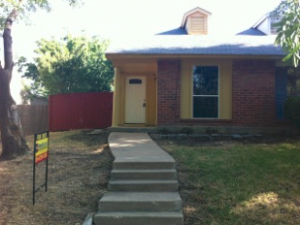 The good news about investing in residential real estate is you’ve got some options.
The good news about investing in residential real estate is you’ve got some options.
You can tailor your approach to what appeals to you and what works for you and what fits for you.
You can look at three areas.
- First, look at your personal interests. What do you enjoy doing? You may be the type of person who likes to swing a paint brush or a hammer. That may direct you a certain way in your real estate investing, which I will explain more later on.
- Second, look at your investing objectives. Are you someone looking to create long-term wealth through long-term cash flow and equity gains? Or are you someone whose objective is to generate very short-term profits or short-term gains? That will also influence how you want to proceed with your part-time or weekend real estate investing.
- Third, look at your resources. Things like time, capital, and the resources you have to enable your access to distressed or discounted properties. Also, the accessibility you have to a good network, whether buyers of properties, sellers of properties or those who can help you fix and maintain properties. All these resources will impact how you want to proceed as a part-time real estate investor.
Once you evaluate these three areas, you will find your niche.
Three fundamental types of investing for the part-timer
We are going to focus on three specific types of investors. They are very fundamental investor types. There are many other types, but let’s focus on the three fundamental types of investors you may find yourself becoming after you evaluate your interests, objectives and resources.
As a HomeVestors franchisee in Dallas and a full-time real estate investor, I have experienced all three of these. I do all three of these types of investing, today, but I started with just one type of investing as a part-time investor.
The buy-and-hold investor
I started out as our first investor type – the buy and hold investor.
That is just a fancy way of saying “landlord” – a person who buys residential real estate with the intent and objective of fixing them up and then renting them out to tenants over the long term.
This is not a short-term transaction.
This is a very long-term engagement where you buy the house and keep it for a matter of years.
You create wealth and income by placing tenants in those properties and collecting monthly rent.
The rehabber
Secondly, you may find you want to be a rehabber. That is that person you see on those Saturday afternoon TV shows which are so popular now. Those folks, the husband and wife couple in many cases, are out there fixing and flipping properties. They are buying single-family residences, going in and remodeling them and placing them on the retail market with a Realtor and selling them. We’ll call that type of investor a rehabber.
The wholesaler
Finally, the third type of investor is the wholesaler. This may be the type with whom the part-time investor is least familiar. The wholesaler is somebody buying residential real estate at a deep discount and quickly selling it “as is.” This investor is not investing a lot of time or money in the properties. He or she is finding them discounted enough to be able to quickly sell them to another investor, off-market, not on the Multiple Listing Service, typically for cash, not using any type of formal funding. This may be, initially, the least likely option for a part-time investor.
These are the three fundamental types of real estate investing for the part-time investor. There are so many other ways to get into real estate investing, such as seller financing, hard money lending, or note buying, or subject-to buying. Those are all very valid real estate investment techniques, but they are also very advanced. I do not recommend them for the part-time investor, the new investor or the weekend investor. Those are a different topic for a different time for a different audience.
Let’s look at these three types of investors, now that you have figured out what you enjoy or what you have in terms of interests, objectives and resources. Let’s see where you fit into one of the three buckets: buy and hold, rehabber or wholesaler.
The buy-and-hold investor
Let’s do buy-and-hold, first. This is how I started as a part-time real estate investor. I had a full-time career and I  wanted to invest in real estate and I decided to become a buy-and-hold investor. I started buying properties right off the Multiple Listing Service using a Realtor. I fixed them up and I put tenants in them. I still hold those properties, today, even in my life as a HomeVestors franchisee and a full-time investor.
wanted to invest in real estate and I decided to become a buy-and-hold investor. I started buying properties right off the Multiple Listing Service using a Realtor. I fixed them up and I put tenants in them. I still hold those properties, today, even in my life as a HomeVestors franchisee and a full-time investor.
The pros of the buy-and-hold investor? Excellent way for long-term wealth creation. What this means is that the buy-and-hold investor enjoys a nice monthly cash flow from the rent collected – once expenses are paid, pocketing the cash flow as monthly income or profit. This type investor also enjoys monthly equity gains. That tenant who occupies that property is paying down that mortgage every month. That equity is ultimately that landlord’s or that buy-and-hold investor’s.
He or she will capture that equity upon sale of that property. In addition, that investor is also gaining equity as that property appreciates over time due to market conditions.
Remember, you’ve got to manage these rental properties. You can do it yourself or you can pay somebody. The old adage of taking on “tenants and toilets” can create problems and headaches – though not always. Be aware of that buy-and-hold investing is also going to require capital. Rental property purchases will likely require 20 percent down, depending on your financing strategy and then there will be rehab, upkeep and on-going maintenance. So be prepared for some initial cash outlays and some future expenses.
Finally, this is not a get-rich-quick investing approach. This is a slow, wealth gaining approach to investing when you are a buy-and-hold investor.
The rehabber
Secondly, maybe rehabber is your bucket. This is that fix-and-flip person you see on TV. The pro of this approach is  that this is great for you if you like to swing a hammer on the weekends or evenings or if you like the whole transformational process of fixing up a house and making it nice again, even if you choose not to do the work yourself.
that this is great for you if you like to swing a hammer on the weekends or evenings or if you like the whole transformational process of fixing up a house and making it nice again, even if you choose not to do the work yourself.
Financially it’s a great way to maximize profits and gains – buying distressed real estate, fixing it and selling it on the market for its maximum market value.
You are going to maximize your profits in a very short term. Not in terms of streams of cash for long-term cash flow, but in immediate clumps of cash or profit when you sell that house.
The other benefit here is you do not need a big, established network of investors to buy your house because you are going to sell it on the retail market, catering to retail buyers who already exist and are easily accessed as a result of listing your property on the MLS with a Realtor. Also, you can often find properties to purchase and rehab on the MLS so you do not always need creative ways to find good properties to flip. You can find them on the open retail market.
Be careful, though. There’s a big time investment here. You may be working on this property and if you are not doing the work yourself, you may be managing the contractors who do. It’s going to take time to fix it and market it. You also have some cash investment here – purchasing the property with cash or at least, some money down, and then funding the rehab. So be prepared to tie up some cash while you own the property.
There’s risk. I guarantee you will be fixing and paying for something that you never dreamed you would. Whether it’s a roof, an air conditioner, a toilet or a tub, it’s going to happen. So be prepared and do your due diligence before buying a fix-and-flip property.
The wholesaler
Finally, let’s look at the wholesaler. It is probably the least realistic to a part-time investor.
The wholesaler typically buys properties at a deep discount and quickly sells them for cash without doing any work on them – maybe mowing the yard and cleaning up the house but that’s about it. The properties are typically sold to an established network of investors.
The pro on this is the short-term gains. You can make money very quickly buying and selling. You are not spending a lot of time rehabbing. You sell to an investor who will do the rehab work or keep it as a rental. And, there is an element to this called assignments where you can buy properties no money down and assign them to other investors and make a nice profit that way.
One thing you need to watch for in wholesaling and why it is the least popular for the part-time or new investor is that you have to have access to properties at a deep discount. You are not going to find these on the MLS or the retail market – you need to have access through some personal marketing you are doing, like “I buy houses for cash.” That marketing effort enables you to buy properties at a deep enough discount to sell them to other investors with enough “meat on the bone” for that other investor, whether they choose to rehab it or rent it.
The other challenge for a part-time investor with wholesaling is that you need to have a good network of buyers.
You need to have investors with whom you have worked and whose trust you have gained and they know you buy good properties and price them, correctly. Furthermore, another challenge for the new or part-time investor, as a wholesaler, you must have a way to make investors aware of your properties – marketing – so they can purchase them from you. These are different buyers than you would get off the traditional retail market or the MLS. They are looking to buy quickly for cash, as is, and you need to have access to those investors. These are people you seek out and develop relationships with over time.
Bottom line, focus on whatever your interests may be – what you enjoy, what your objectives are-short-term or long-term gain and what resources you have – time, capital and access to properties and buyers.
Think about those and then determine which of these three buckets you fit into. Whether it’s buy-and-hold, wholesaler or rehabber, you can be the investor you want to be, based on your interests, your objectives and your resources.


























0 Comments